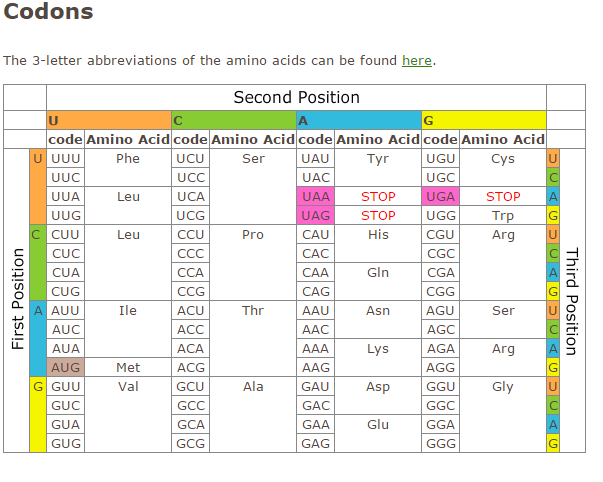

In part, this redundancy results from the attachment of many amino acids to more than one species of tRNA. Thus, most of the amino acids are specified by more than one codon. Of the 64 possible codons, three are stop codons that signal the termination of translation the other 61 encode amino acids (see Table 3.1). The significance of this unusual base pairing in codon-anticodon recognition relates to the redundancy of the genetic code. Codon-anticodon base pairing is somewhat less stringent than the standard A-U and G-C base pairing discussed in preceding chapters. (more.)Īfter being attached to tRNA, an amino acid is aligned on the mRNA template by complementary base pairing between the mRNA codon and the anticodon of the tRNA. In the second step, the amino acid is transferred to the 3´ CCA terminus of the acceptor tRNA and AMP is released. In the first reaction step, the amino acid is joined to AMP, forming an aminoacyl AMP intermediate. Recognition of the correct tRNA by the aminoacyl tRNA synthetase is also highly selective the synthetase recognizes specific nucleotide sequences (in most cases including the anticodon) that uniquely identify each species of tRNA.Īttachment of amino acids to tRNAs.

In some cases, the high fidelity of amino acid recognition results in part from a proofreading function by which incorrect aminoacyl AMPs are hydrolyzed rather than being joined to tRNA during the second step of the reaction. The aminoacyl tRNA synthetases must be highly selective enzymes that recognize both individual amino acids and specific base sequences that identify the correct acceptor tRNAs. The activated amino acid is then joined to the 3´ terminus of the tRNA. First, the amino acid is activated by reaction with ATP to form an aminoacyl AMP synthetase intermediate. The reaction proceeds in two steps ( Figure 7.2). Each of these enzymes recognizes a single amino acid, as well as the correct tRNA (or tRNAs) to which that amino acid should be attached. The attachment of amino acids to specific tRNAs is mediated by a group of enzymes called aminoacyl tRNA synthetases, which were discovered by Paul Zamecnik and Mahlon Hoagland in 1957. The incorporation of the correctly encoded amino acids into proteins depends on the attachment of each amino acid to an appropriate tRNA, as well as on the specificity of codon- anticodon base pairing. Modified bases are indicated as mG, methylguanosine mC, methylcytosine DHU, dihydrouridine (more.) The structure of yeast phenylalanyl tRNA is illustrated in open “cloverleaf” form (A) to show complementary base pairing. The mRNA template is then recognized by the anticodon loop, located at the other end of the folded tRNA, which binds to the appropriate codon by complementary base pairing. All tRNAs have the sequence CCA at their 3´ terminus, and amino acids are covalently attached to the ribose of the terminal adenosine. The adaptor function of the tRNAs involves two separated regions of the molecule. X-ray crystallography studies have further shown that all tRNAs fold into similar compact L shapes, which are likely required for the tRNAs to fit onto ribosomes during the translation process. Transfer RNAs are approximately 70 to 80 nucleotides long and have characteristic cloverleaf structures that result from complementary base pairing between different regions of the molecule ( Figure 7.1). However, they also possess unique identifying sequences that allow the correct amino acid to be attached and aligned with the appropriate codon in mRNA. As might be expected, given their common function in protein synthesis, different tRNAs share similar overall structures. All cells contain a variety of tRNAs that serve as adaptors for this process. During translation, each of the 20 amino acids must be aligned with their corresponding codons on the mRNA template.


 0 kommentar(er)
0 kommentar(er)
